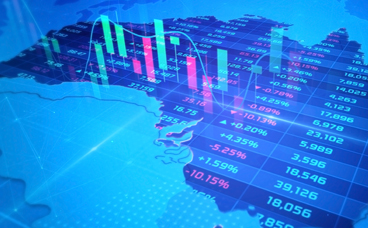Investment Watch: Spring 2025 Outlook
Investment Watch is a quarterly publication offering insights into equity and economic strategy. This edition explores expected interest rate trends, their impact on asset allocation, and highlights key Australian sectors and tactical opportunities.
Investment Watch is a quarterly publication produced by Morgans that delves into key insights for equity and economic strategy.
This publication covers
Economics - 'A comparative outlook on the Fed and RBA'
Asset Allocation - 'Countering uncertainty'
Equity Strategy - 'Broadening our portfolio exposure'
Banks - 'Price strength compresses potential returns'
Industrials - 'Wild swings'
Resources and Energy - 'Sentiment turning'
Technology - 'Buy quality when opportunities arise'
Consumer Discretionary - 'Encouraging medium-term signs'
Telco - 'Defensive attributes remain attractive'
Infrastructure - 'Attractive, but with limited opportunities'
Property - 'An improving cycle'
Recent Intiations
As we approach Q4, we maintain our positive view on investment markets, grounded in the expectation of slowing but still positive global growth. The shift in market dynamics is driven by the resumption of US Fed rate cuts and the continued acceleration of tech innovation and productivity gains. We think these factors will mitigate the impact of ongoing economic challenges and geopolitical volatility. This quarter, we map the outlook for interest rates and how this shapes our asset allocation decisions. We also provide an outlook for the key sectors of the Australian market and where we see the best tactical opportunities
Morgans clients receive exclusive insights such as access to our latest Investment Watch publication. Contact us today to begin your journey with Morgans.
The Australian economy, challenge and opportunity
Today we want to talk about the unusual group of challenges which the Australian economy now faces. We will then move on to look at some remarkable opportunities.
Last year 2024, the US economy grew by 2.2%. We think it will grow in 2025 by 1.8%. This modest slowing of growth is occurring as the Fed Reserve achieves a soft landing in the US economy.
We expect that the Fed Reserve having achieved that soft landing, will undertake a series of rate cuts, with the first beginning in the meeting of 10 December this year. We expect a single rate cut of 25 basis points of that meeting with a further 25 basis points at the next meeting in the new year. This will bring down the Fed Funds rate to our estimate of neutral.
The Fed might reasonably be expected to cut rates further to provide a genuine stimulus for recovery in the US economy later in the year. We expect that after growth of 1.8% in 2025, growth should accelerate to 2.2% in 2026.
Australia is in an international environment where growth in 2026 is expected go be better than growth in 2025. The Australian economy is recovering within this positive international outlook. After 1.3% growth in 2024, we expect the Australian economy to grow by 2.1% in 2025. This should then be followed by an improvement in growth to 2.3% in 2026.
The problem Australia has, in the short term, is a rebound in inflation. After 2.4% inflation in 2024, it is likely that CPI headline inflation will reach 3.8% in 2025. Indeed it already reached this number for the year to October 2025. Depending on government action, we think inflation might ease to a headline level in 2026 of 3.0%.
Chart 1: Electricity Rebate Price Chart – October monthly CPI

In this chart above, the blue line represents the actual cost of generating electricity in Australia over the period from June 2023 to October 2025. The black line below it is the actual retail cost to Australians after Fed govt subsidies have been provided to reduce the retail price. Since June 2023, the Fed govt has provided five Energy Bill Relief Fund (EBRF) rebates. These are provided by the Commonwealth to individual States to subsidise and reduce the retail price in their own State.
The black line represents the series which is used for electricity in the Australian consumer price index (CPI). Our observation is that rises and falls in this measure also affect the broader CPI after a lag of two quarters. This is important because we can see that between June 2024 and October 2024, this measure of electricity prices fell from 107.4 in June to 69.9 in October 2024.
Our belief it was this decline in subsidised electricity prices which allowed the decline in the CPI in Australia in the first half of 2025. This in turn generated an environment for the RBA to cut rates.
After reaching its low of 69.5 in 2024, the retail index rose gradually as the subsidies from the Fed govt declined. This led this component of the CPI to rise to 114.3 in June 2025. This was a rise of 44.8%. It is this rise which months later is feeding its way into the Australian CPI and causing a sharp move up in the CPI as we move towards the end of calendar 2025.
By the time of the October CPI, this had led that index to rise at a rate of 3.8% from the level the year before. What happens in the future to this component of the CPI is entirely dependent upon govt policy. A previous statement by the Treasurer is that no more subsidies will be provided by the end of this year. We will have to wait and see what emerges in the budget for 2026.
Our major concern is not with the series including government rebates. Our major concern is with the cost of generating electricity, excluding the electricity rebates. We now turn our attention to light blue line. This shows that the cost of generating electricity rose from an index level of 100 in June 2023 to 121.9 in October 2025. This is a rise of 21.9% in two years.
In this period the Australian economy is undertaking an energy transition to renewable generating system. This means that an increasing amount of electricity is being generated by solar panels and wind mills. Our understanding is that at the time of writing, this renewable component of electricity has now risen to 36% of total electricity output. We are told that these forms of renewable energy are the cheapest form of generation. Why therefore has the price made such a significant rise?
It is true that solar panels and windmills will generate very cheap energy for periods of time during the day. The problem however is opposed to the variable generation of energy for parts of the day, consumers demand that electricity be available 100% of the day. This ability is provided by forms of energy which stabilise or “firm” generation so that power will be available 100% of the day. At this time, the only form of energy which can currently provide this stability at scale comes from gas peaking plants. This means that natural gas is the form of energy which provides the last marginal unit of production which makes electricity available. Economists know that for a market to clear and a product to be available 100% of the day, then the price of the good must be equal to the last margin unit of production. In this case that last margin of production is provided by natural gas. So the pricing of renewal energy is governed by the pricing of natural gas.
This means that renewable energy will be very cheap if that natural gas is available at a cheap price. This for example was the case in Germany before the war in the Ukraine. Up until that time, the last unit of renewable energy was being provided by very cheap natural gas.
What then happened was that that very cheap Russian natural gas was replaced by more expensive Norwegian gas and even more expensive gas provided by American LNG.
In the long term, it is the price of natural gas which is determining the increasing cost of Australian renewable energy. In the short term, anecdotal evidence suggests the rise in electricity price in eastern Australia followed the closure of the Liddell Power Station near Muswellbrook in 2023. The station had four 500Mw generating units with the last taken off line in April 2023. At the time of closure, Liddle was supplying 10% of NSW electricity demand. This closely tallies with the escalation of electricity generation cost in mid 2023. This suggests that the problem is not whether renewable energy is or is not preferable to coal power electricity. The issue is that there in not enough electricity currently being generated. It is this shortage of electricity which has generated an increase in price. We note that the electricity price in the chart above Excluding Government Electricity Rebates, increases in price immediately after the time when Liddell power station is withdrawn from service.
The result of this inflation influence from electricity prices is that the Australian cash rate will rise during calendar 2025. Our model of the cash rate currently suggests two rate hikes each of 25 basis points in the first half of 2026. This will take the Australian cash rate to 4.1%.
At the same time that the Australian cash rate is rising, the US Fed Funds rate should be falling. Our model of the Fed Funds rate currently suggests an equilibrium level of 3.32%. This suggests two rate cuts, the first in December 2025 and the second in the first quarter of 2026.
The fact that the Fed Funds rate should fall at the same time as the Australian cash rate should rise, immediately suggests a rise in the Australian dollar. We expect the $A/$US exchange rate to rise to US71cents by the middle of 2026.
The falling Fed Funds rate should of course put downward pressure on the US dollar. This will in turn allow a revival of commodity prices. We expect a broad based recovery in commodity prices, beginning with soft commodity prices. The fall in the $US should generate a significant recovery in the price of wheat, corn and cotton. Following the recovery in soft commodities, we should see the beginning of recovery in oil and gas. This recovery in oil and gas is in spite of the very pessimistic outlook that is currently gripping the energy market. This broad recovery in commodities should generate a healthy recovery in Australian cyclical stocks.
Chart 2: Seasonality ASX200 versus S&P500

Our model for the S&P500 and the ASX200 both show that both these markets are overbought. This means that they are both significantly higher than the fair value presented by our model. This level of over-valuation is not unusual at this time of the year. Our chart above shows average seasonal variation in both the S&P500 and the ASX200. Both rally to near term peaks in November and December. These seasonal peaks are then followed by a correction continuing up until March/April.
We think this kind of seasonal correction is likely to follow in coming months. The correction should be mostly completed by the end of March 2026. The correction on a seasonal basis because at the end of the European financial year in March, investment institutions tend to withdraw from the market ahead of their end of financial year balanced dates.
In summary, our view is that both the Australian economy and the US economy, still share an outlook for healthy growth. A fall in the $US as we go into the early months of calendar 2026, should have the result of a broad recovery in commodity prices. This should generate an earnings recovery for Australian stocks.
In the very short term, we think both the US and Australian markets are overbought. Still, if we are patient, by the time we get to the end of the first quarter, a strong outlook of market recovery should then arise
FAQs
What is the Australian GDP forecast for 2026?
We expect GDP growth of around 2.1% in 2025, improving to about 2.3% in 2026 as global conditions and domestic demand firm.
Why is inflation rising in Australia in 2025?
Retail electricity prices rebounded as subsidies eased and generation costs climbed, feeding into CPI with a lag. Tight supply conditions have amplified the effect.
How will interest rates change into 2026?
Our base case is two RBA hikes (2 × 25 bps) in the first half of 2026, while the Fed trims its policy rate. The divergence favours a stronger AUD.
What role does renewable energy play in electricity prices?
Renewables lower average costs when firming is efficient and gas is cheap. When firming costs rise or gas supply tightens, wholesale prices increase.
Is the Australian economy outlook 2026 positive for markets?
After a seasonal correction into March/April 2026, a softer USD and recovering commodities should support Australian cyclicals and broader market performance.
Superannuation Changes in 2026: What Div296 and PayDay Super Mean for Your Wealth
Key Takeaways
- Div296 overhaul introduces tiered tax rates for super balances above $3M and $10M, starting 1 July 2026.
- PayDay Superannuation law requires employers to pay Super Guarantee within 7 business days of wages.
- Economic outlook for 2026 shows steady growth and opportunities for investors.
- SMSF members must take extra care to meet annual minimum payment requirements to avoid losing the pension exemption.
- Age pensioners have a bit more flexibility without earned income affecting their pension benefits.
Introduction
More superannuation reforms are coming in 2026, which will impact high-balance super holders and employers. The government has revised Div296 policy and the new PayDay Superannuation legislation aims to improve fairness and compliance in Australia’s retirement system. Combined with a shifting economic outlook, these changes make it critical to review your strategy now.
This guide explains what’s changing, why it matters, and how you can prepare.
Div296 Explained: New Rules for High-Balance Super Accounts
From 1 July 2026, the government will implement a tiered tax system for large super balances if legislation is implemented:
What this means for you:
- If your Total Super Balance (TSB) exceeds $3M, a portion of your earnings will attract higher tax.
- SMSF members and defined benefit interests are included.
- The ATO will calculate liabilities, but funds must report realised earnings.
Action steps:
- Clients should hold off taking any action until we know more. There are still many details yet to be clarified with the amended Div296 policy so we ask clients to continue to be patient.. Continue to speak to your adviser, who will keep you updated when further details are released by the government.
PayDay Superannuation: On-Time Employer Contributions Become Law
The Treasury Laws Amendment (PayDay Superannuation) Bill 2025 introduces a major compliance shift:
- Start date: 1 July 2026.
- New rule: Employers must pay Super Guarantee within 7 business days of paying wages (Qualifying Earnings).
- Penalties: Increased fines for late payments.
- Impact: Small businesses may face challenges adapting to real-time reporting. The change in timing of SGC payments in the first year may result in employees exceeding their concessional contribution cap if they are also salary sacrificing into super.
Why it matters:
This change aims to reduce unpaid super and improve retirement outcomes. Employers should ensure they understand this new law by utilising available education tools and resources that are available. Payroll systems will need to be updated and staff educated prior to 1 July commencement date.
Economic Outlook for 2026: What Investors Should Know
Australia’s economy is forecast to improve to 2.3% in 2026, with inflation easing to 3.0%. Key trends include:
- AUD strength: Expected to rise to US70 cents in 2026.
- Commodity recovery: Wheat, corn, and soybeans undervalued, leading to opportunities for agribusiness investors.
- Global stability: Growth is healthy but not spectacular.
Investor takeaway:
Diversification across all asset classes and sectors remains critical.
Practical Steps to Prepare
For Individuals
- Review super contributions strategies to ensure caps won’t be breached, and ensure annual minimum pension payments are made.
- Understand Work Bonus rules if you’re a pensioner and partake casual work.
For SMSF Trustees
- Ensure compliance with updated ATO rulings on income streams and minimum payment standards.
For Employers
- Seek advice on what upgrades need to occur to your payroll systems in preparation for PayDay Super compliance.
Conclusion
Once again, 2026 brings more superannuation changes. Whether you’re an investor, employer, or retiree, proactive planning is essential to protect and grow your wealth.
Ready to prepare?
Speak to a Morgans adviser today for tailored strategies on superannuation, SMSF compliance, and investment planning.
Morgans clients receive exclusive insights such as access to our latest Your Wealth publication.
Contact us today to begin your journey with Morgans.
FAQs
1. What is Div296 and who does it affect?
Div296 applies to individuals with super balances above $3M. It introduces higher tax rates on realised earnings for large balances.
2. When does PayDay Super start?
The law takes effect on 1 July 2026, requiring employers to pay super within 7 business days of wage payment.
3. Will unrealised gains still be taxed?
No. The new system taxes realised gains only, aligning with existing income tax concepts.
4. How can I prepare for these changes?
Some changes such as Div296 are not yet legislated so no action should be taken yet until details are clearer. For PayDay Super changes, employers should review their payroll systems and seek professional advice..
5. Where can I find official guidance?
Visit the ATO website and Treasury fact sheets for detailed updates.
Introduction
Michael Knox, Morgans Chief Economist, shares his latest quarterly outlook on global growth, inflation, commodities, and interest rates. Here are the key takeaways for November 2025.
Global Growth Outlook
Growth is slowing but stabilising across major economies:
- US: Eases to 1.8% in 2025 (including effects of US shutdown), recovering to 2.2% in 2026.
- Euro Area: Improves to 1.2% in 2025.
- China: Slows to 4.8%.
- India: Strong at 6.6%.
- Australia: Firms to 1.9%, inflation at 3.5%.
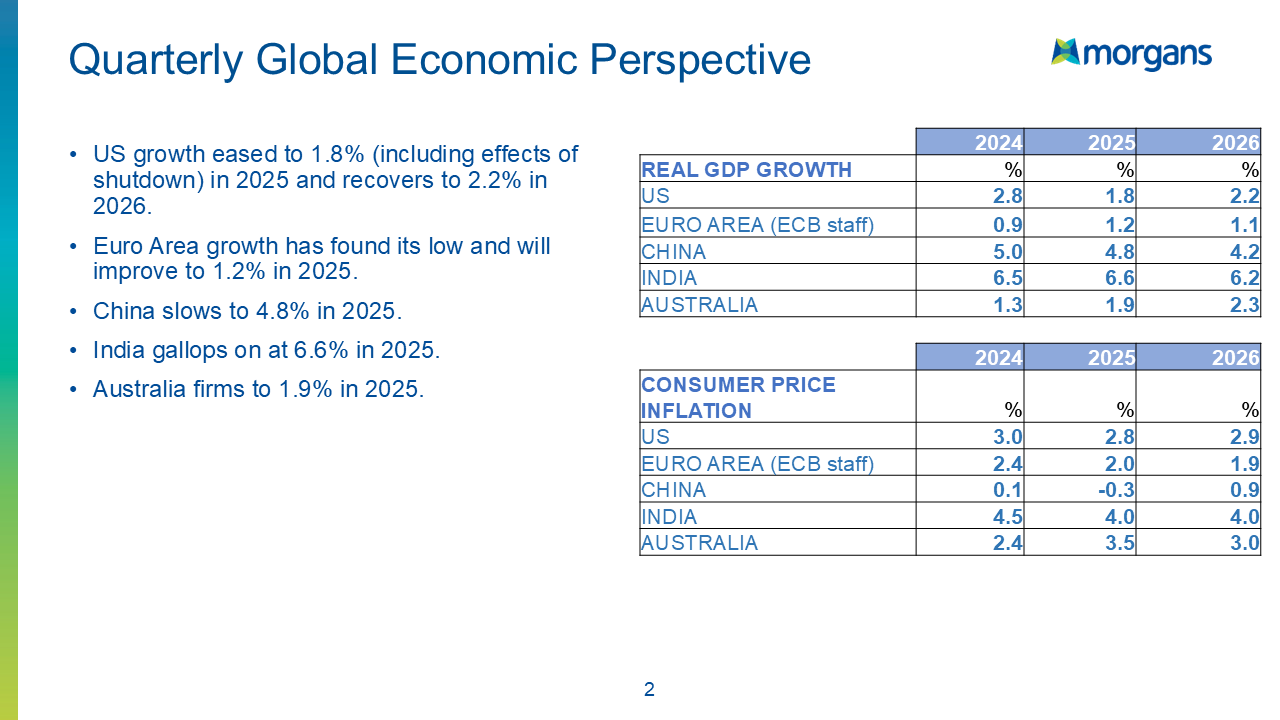
Australia: Inflation & Employment
- Retail electricity prices are rising as subsidies end, adding pressure to inflation.
- Employment growth is soft at 1.5%, below the median of 2.17%.
- Unemployment near 4% suggests inflation around 3.4%, above the RBA target.

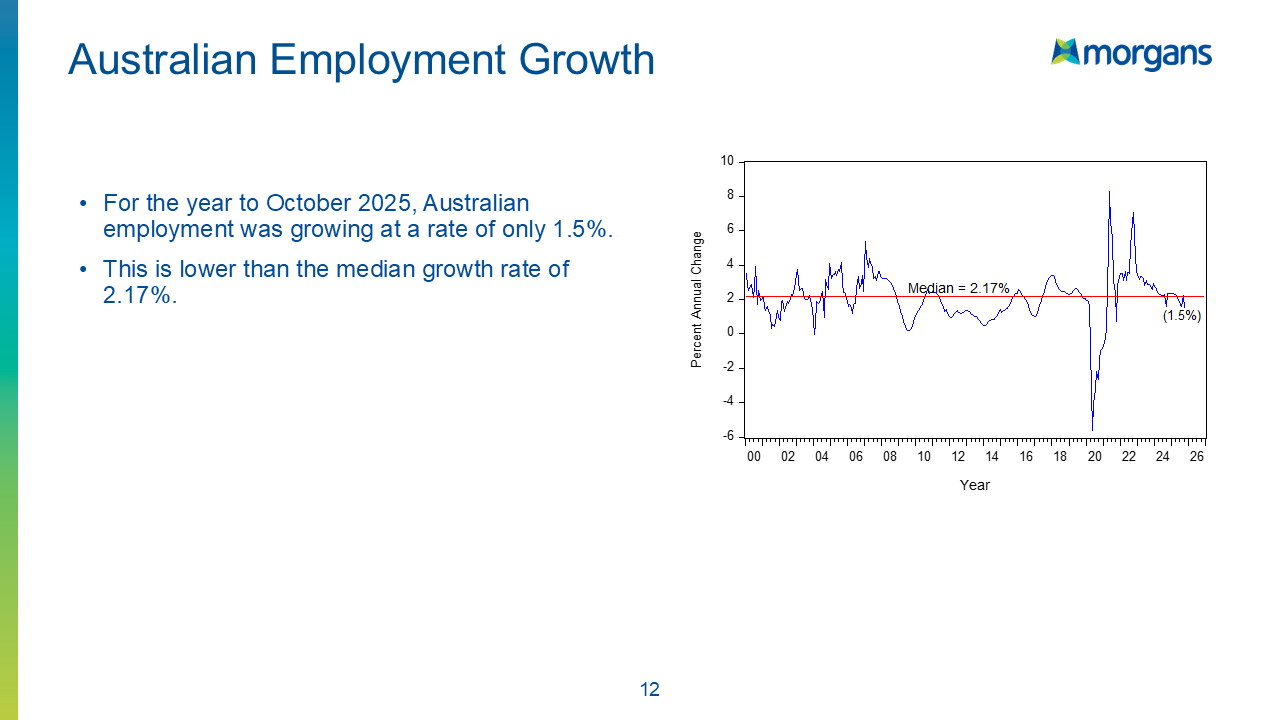
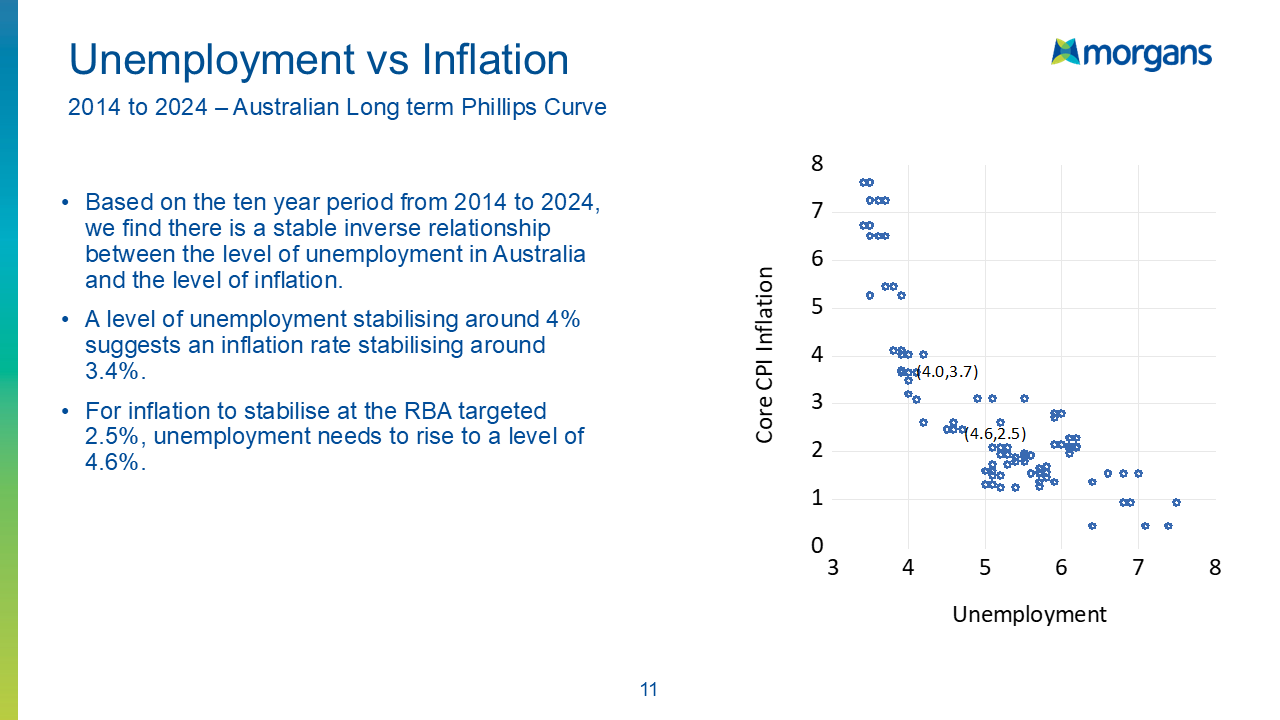
Interest Rates & Monetary Policy
- RBA cash rate expected to rise to 4.1%, driven by higher core inflation.
- In the US, below-trend growth signals potential Fed Funds rate cuts ahead.
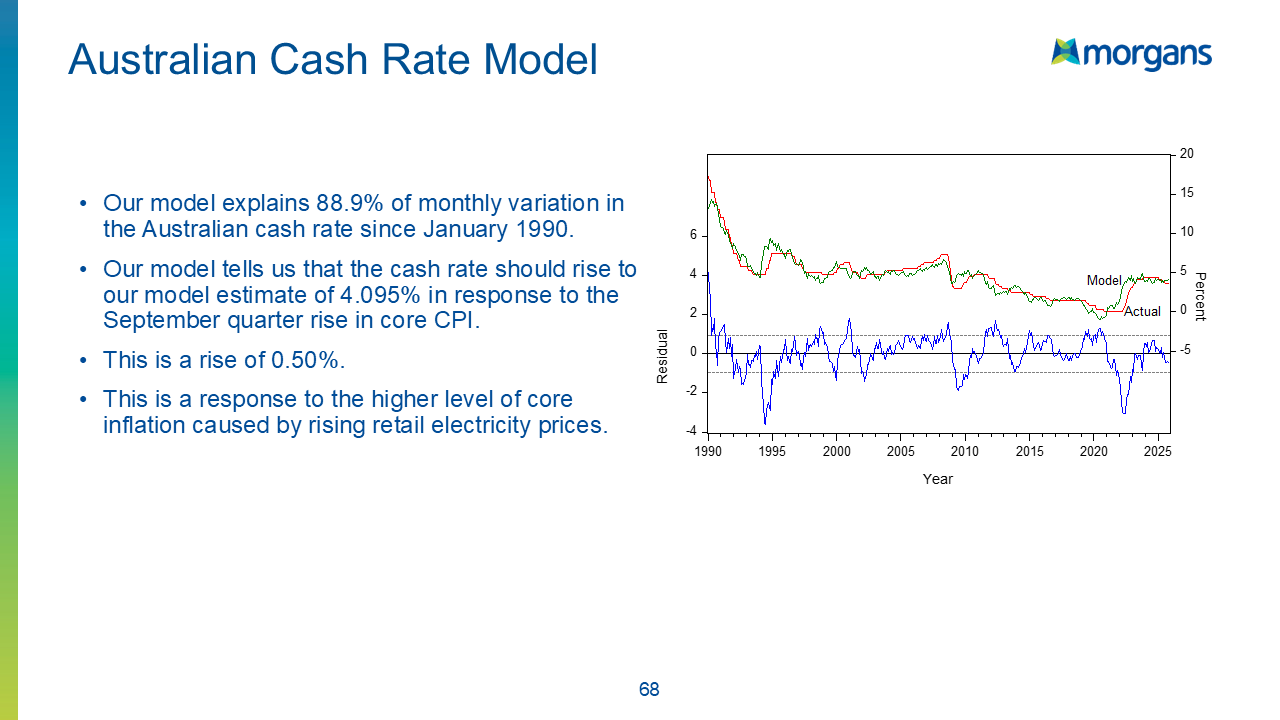
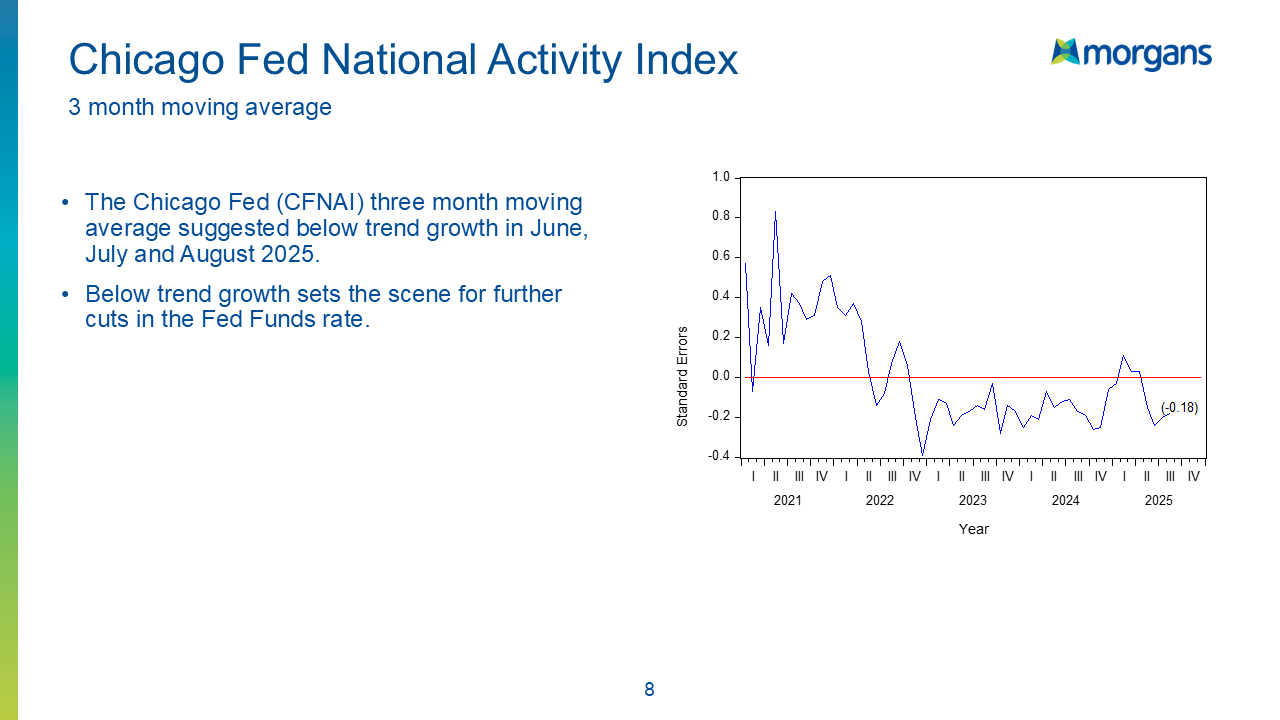
Commodities Snapshot
- Iron Ore: Slightly above fair value at US$100.80.
- Copper: Significantly overvalued at US$10,225 per tonne.
- Nickel & Zinc: Moderately undervalued.
- Gold: At record highs (US$4,013 per ounce) with limited upside.
- Soft Commodities: Wheat and cotton remain undervalued, presenting potential buying opportunities.
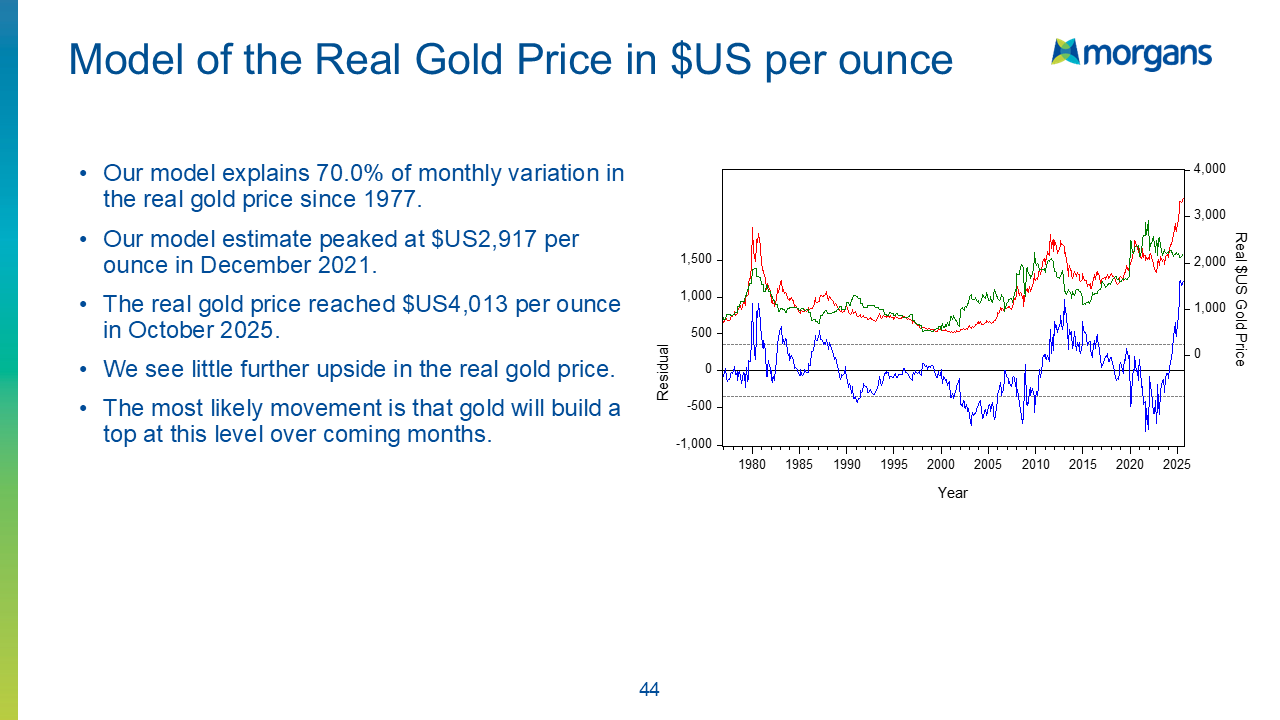
Equities Outlook
- S&P500: Model suggests fair value above current levels, but earnings expected to ease in Q4.
- ASX200: Trading well above model estimates, indicating strong sentiment.
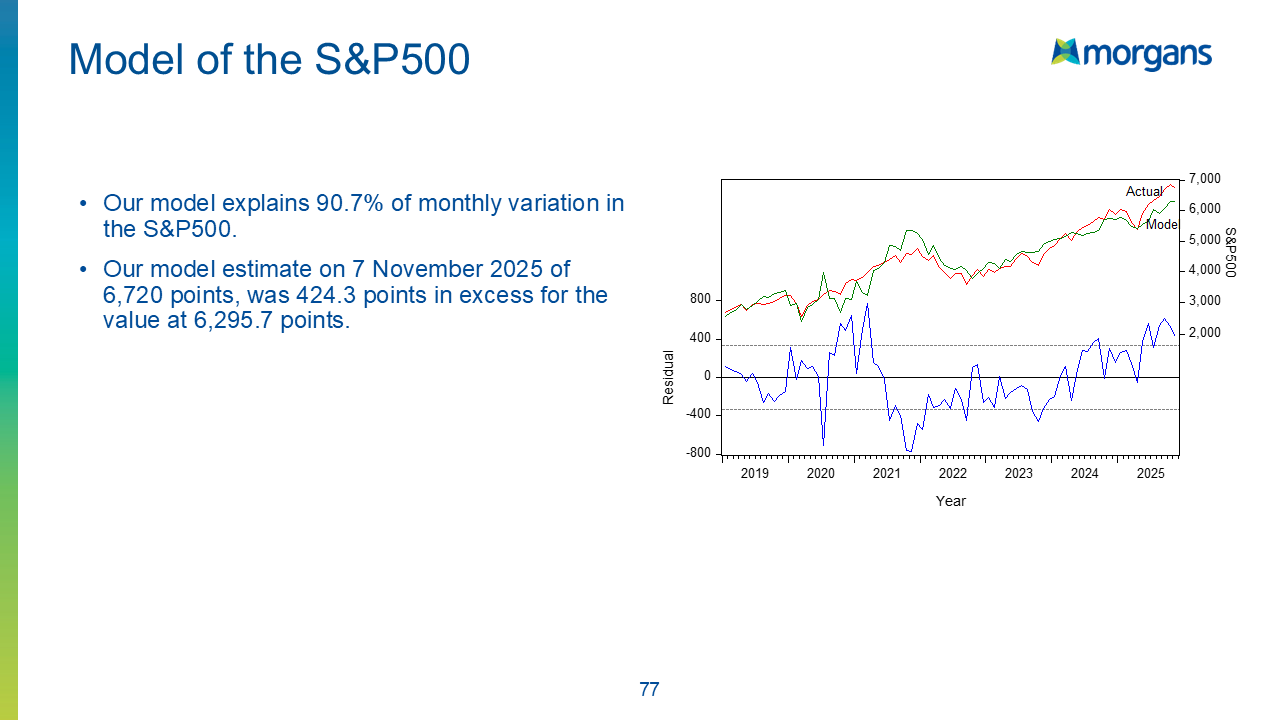
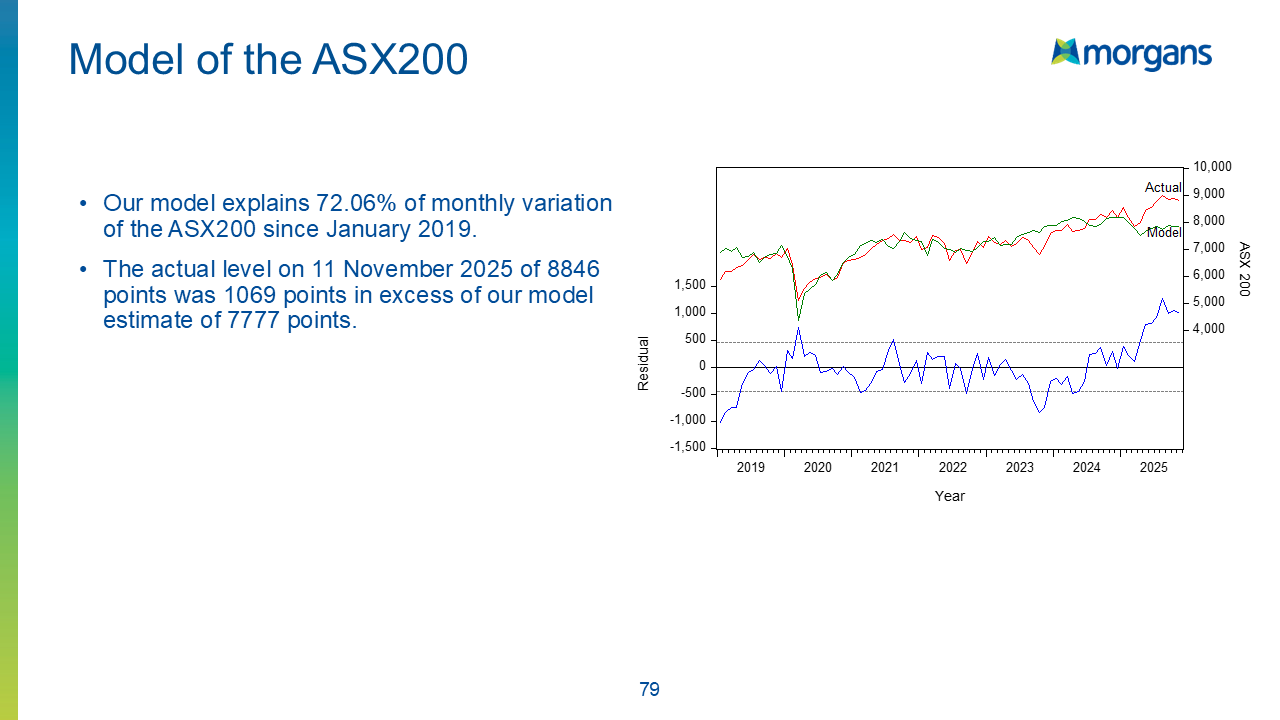
Currency & Bonds
- AUD/USD: Model estimate at US70.94 cents, above current level of US65.48 cents.
- US and German bonds appear moderately overvalued, reflecting strong foreign buying.
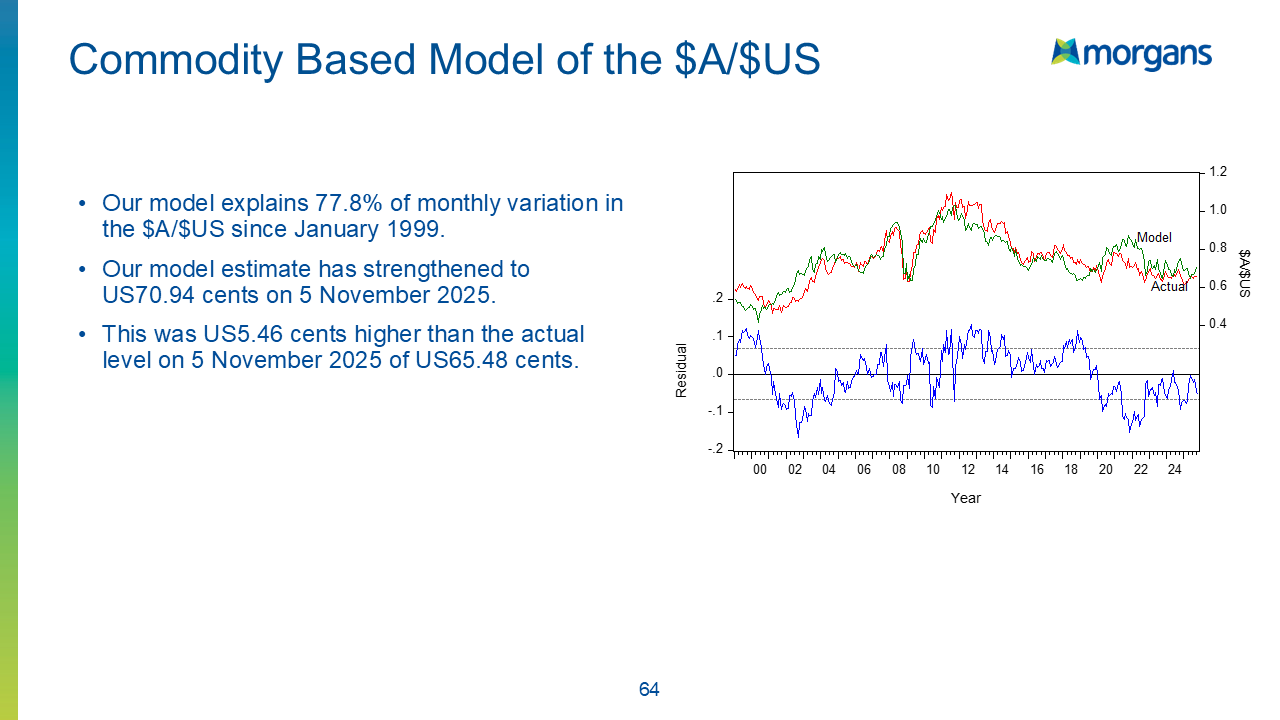
Closing Thoughts
Global growth is slowing, but commodity markets and equities show mixed signals. Inflation pressures in Australia suggest further rate hikes, while US policy may ease. Investors should watch undervalued opportunities in soft commodities and monitor interest rate trends closely.
FAQs
1. What is the outlook for global economic growth in 2025?
Global growth is slowing but stabilising. The US is expected to grow at 1.8%, the Euro Area at 1.2%, China at 4.8%, India at 6.6%, and Australia at 1.9%.
2. Why is Australian inflation expected to remain high?
Inflation pressures are driven by rising retail electricity prices as subsidies end, combined with relatively strong demand and employment trends.
3. Will the Reserve Bank of Australia raise interest rates?
Yes, the RBA cash rate is forecast to rise to around 4.1% in response to higher core inflation.
4. Which commodities are currently undervalued?
Soft commodities like wheat and cotton are significantly undervalued, while iron ore is near fair value and copper remains overvalued.
5. How are equity markets positioned heading into 2026?
The S&P500 is trading below model estimates, suggesting potential upside, while the ASX200 is above fair value, reflecting strong investor sentiment.
DISCLAIMER: Information is of a general nature only. Before making any financial decisions, you should consult with an experienced professional to obtain advice specific to your circumstances.
Why The US Has Higher Productivity
Good morning. Today I want to talk about the U.S. economy in comparison, to other economies and, why it's performing, the way it is. The documents I will refer to are first the IMF, outlook, which is, come out in the last two weeks. That gives us some international comparisons.
For the US economy I use, the monthly outlook from Standard and Poor's, which is, the number one rated by the Congressional Budget Office, well ahead of other economic forecasters. For the US economy, both the IMF and, Standard Poor's agree that growth this year should be 2%. Our own model of the US economy, based on the Chicago Fed National Activity Indicator, is also forcasting US growth of 2%.
Still, that's 2% is less whatever the negative effect is from, from the US shutdown. When the shutdown continues for a month, that growth rate falls from 2% down to about 1.8 % 1.7%. So it's a moderate slowdown. Still growth in the U.S. economy accelerates next year to about 2.2%. I'll talk later on where that growth is coming from.
When we look at growth in other areas we see that: Euro area is miserable. Great Britain is growing faster than the Euro area now. This year the UK should grow by 1.3% but, the Euro area should grow by about 1.2% this year. Euro area growth drifts off to an even more miserable 1.1% next year. But fortunately, that generates a lot of savings to invest in other countries like us. Those savings then go in to the US equities and bond markets and, the Australian stock market and places like that.
China is slowing down to 4.8% this year and 4.2% next year according to the, IMF. Still, heroically India, marches on to 6.6% growth this year and 6.2% next year. For emerging markets, which include the Indo Pacific generally ,Growth is proceeding at about 5.2% this year and 4.7%, next year.
The U.S is still, pretty good in comparison. This year, it's, growing at 2% or, depending on the results of the shutdown. Next US Growth accelerates, to 2.2%, and growth is then about the same the year after.
There's been a lot of debate this year about the effect of tariffs on the US inflation. In spite of higher tariffs , US inflation is stubbornly , stubbornly low. Headline inflation, which includes food and energy this year should be only 2.8%. Hardly something to scare markets. And that continues a 2.9% next year and 2.5% the year after. Amazingly,US core inflation is a bit higher than that 3% this year and 3.3% next year. It's just that food and energy prices are falling in the US. Why can't that happen here?
Lets look at one of the reasons that you get really quite steady growth and relatively low inflation in the US The comparison I want to make here is between US output per hour and Australian output per hour. In the beginning of this year, we had a shocking slowdown in productivity growth because our government decided that was better to hire more, people from the public service than generate employment in the private sector. It is well known that, productivity in the market economy grows much faster than in the, than in the public sector. So, for the first quarter, productivity in Australia grew, or output per hour worked per annum ,grew by 0.3% . The RBA has told us that, they expect output per hour that will rise to about 0.7%per annum , the same as the UK. And we'll be able to maintain productivity growth rate of 0.7%, going forward.
Let's compare that to what's happening in the US economy. This year It looks like the US will be producing labour productivity much higher than the Australia. US Output per hour should grow by 1.6% this year . Next year US Output per hour may grow even more by, 2.1%. Following that US labour productivity the year should grow between 1.6 and 1.7%,. This is full 1% faster than, the Australian economy is expected to grow in terms of productivity. Remember, it's growth and productivity which generates increase in living standards.
There's two reasons, that we can provide for why the U.S., productivity is growing so much faster than ours. One is a flexible labour market. It's an extremely flexible labour market in the US. The current Australian government has made our labour market less flexible, less than it previously was. A second reason is deregulation . The program of deregulation by the US administration is making it easier for business , to do business.
That, of course, in turn generates higher levels of business investment. That higher level of business investments creates more growth. So, it's a series of policies which are different in each country . The result will be that, living standards in, in the U.S are going to start going to be growing significantly faster than they are in Australia.
And that's the end of the good news for the day.
Last time I spoke to you about Australian inflation and its effect on what the RBA might do in its November meeting, I said that expectations for inflation for the year to September, which would be published in October, were between 2.5% and 2.7%. I also said that if inflation came in at the lower estimate of 2.5%, then we could see a rate cut in November.
Well, the numbers are out, and unfortunately, not only are we not getting a rate cut in November, it’s unlikely we’ll see another rate cut any time soon. In fact, it’s fair to say we may be at the very end of the rate-cutting cycle in Australia. The reason is that the core measure, the trimmed mean, which is the RBA’s preferred measure of underlying inflation, came in not at 2.5%, not at 2.6%, and not even at 2.7%, but at a shockingly high 3%.
This result was driven by a 1.3% increase in prices in the previous quarter, which annualises to about 5%, a surprise that wasn’t anticipated. Looking deeper into the quarterly CPI, we saw housing prices rising at 4.7%, health costs up 4.2%, and education costs increasing by 5.3%.
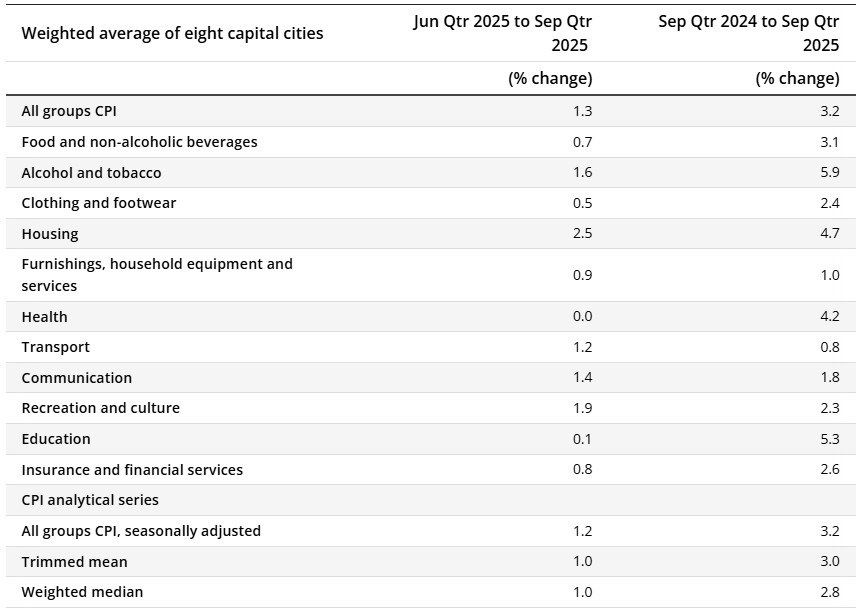
The ABS has indicated that the major source of inflation was a jump in goods inflation, which rose 3%, up 1.1% from the previous quarter, or 4.4% annualised. The standout contributor was electricity, which saw a massive year-on-year increase of 23.6%. Other household fuels actually fell by 1.6%, and annual services inflation was 3.5%.
The ABS attributed this unexpected rise in inflation primarily to electricity prices. But it’s not just electricity prices themselves, it’s the end of Federal Government funding to the states that had been keeping those prices low.
The ABS reported that electricity prices rose 23.6% over the past 12 months, largely because State Government rebates, funded by the Commonwealth under the Energy Bill Relief Fund, have now been used up. These rebates included Queensland’s $1,000 rebate, Western Australia’s $400 rebate, and Tasmania’s $250 rebate. With these rebates exhausted, electricity prices have surged.
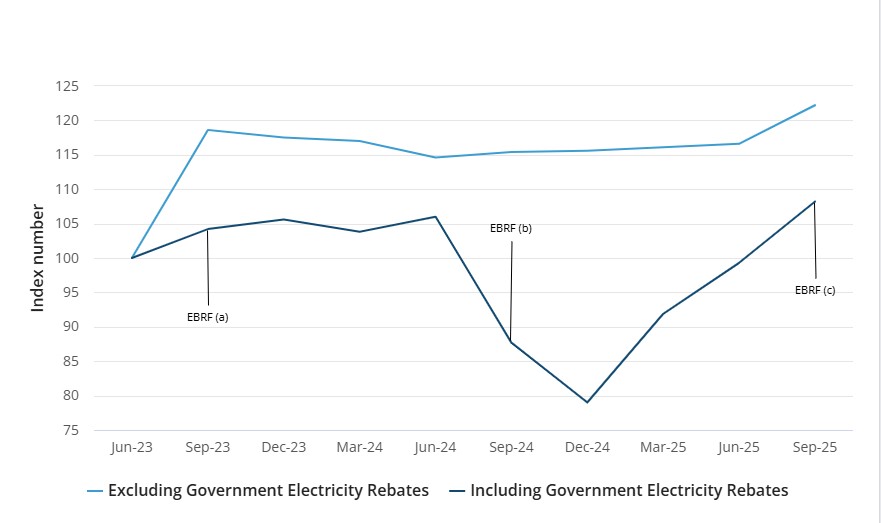
The A
BS data shows electricity prices excluding government rebates, and highlights the impact of the federal funding. Electricity prices really took off in 2023, rising by almost 20%, which posed a political risk for the Federal Government. In response, the Government provided funding to State Governments to suppress those prices. There were schemes in both 2023 and 2024, and ahead of the last election, the subsidised price paid by consumers dropped to around 80% of the original cost, well below the actual cost of generation.
However, since December 2024, those subsidies have been reduced. Over the past year, prices have climbed again, though they remain below the unsubsidised cost, which is now around 122% of the original price, or about a quarter higher than where things stood in 2023.
The result of all this is 3% core inflation. If inflation had come in at 2.5%, rates could have fallen from 3.6% to 3.35%. But with 3% core inflation, rates should need to rise by 25 basis points. That said, we’re likely at the end of the rate-cut cycle.
Is the RBA likely to raise rates? They might consider it, but this is cost-push inflation, not demand-driven inflation, so increasing rates wouldn’t help. It would only worsen the situation. This very high inflation figure, driven by the end of federal electricity subsidies, signals the end of the current series of Australian rate cuts.
Key Takeaways
- Press pause. Park funds safely while you confirm what you received, obligations, and any tax implications.
- Build a plan that fits your goals and timeframes. Prioritise cash buffers, debt decisions, investing, super, and estate wishes.
- Get advice early. A financial adviser and tax accountant can help you avoid costly mistakes and set up a long-term strategy.
- Use professional inheritance financial advice to align tax, super, investing, and estate planning decisions.
Receiving a large inheritance can be life-changing. It can also feel overwhelming. The right first steps help you protect capital, make clear decisions, and turn a windfall into lasting financial security. This guide walks you through a practical process Morgans advisers use with clients every day, with a focus on inheritance financial advice tailored to Australian rules.
Step 1: Pause and assess your situation
Before making big choices, slow down.
- List the assets you have inherited: cash, property, superannuation, shares, term deposits, insurance proceeds, or a business interest.
- Confirm control and timing. Has probate been granted? Are there executor timelines or sale constraints?
- Check any liabilities. Some assets may come with debts, fees, rates, or ongoing costs.
- Gather documents. Will, probate, estate distribution statement, title records, super death-benefit statements, cost-base records for property and shares.
Short term, consider holding funds in high-interest savings or term deposits while you complete the groundwork. ASIC’s Moneysmart has clear tips on handling large amounts of money.
Step 2: Understand the emotional impact
An inheritance often follows the loss of a loved one. It is normal to feel pressure to act quickly. Give yourself time.
- Avoid large purchases until you have a plan.
- Set simple rules. For example, no irreversible decisions for 30 to 90 days.
- Write down your goals and values. What will this money do for you, your family, or future generations?
- If you feel rushed by offers or schemes, step back and check for red flags. Scamwatch has practical guidance.
Step 3: Map your goals and timeframes
Your strategy should mirror when you will need the money.
- 0 to 2 years (short term): capital protection and liquidity. Cash, term deposits, or an offset account.
- 3 to 7 years (medium term): a diversified mix of income and growth.
- 7 years plus (long term): growth-focused assets with disciplined risk management.
Align each dollar with a job: emergency fund, debt choices, home or investment property plans, children’s education, retirement savings, or charitable giving.
Step 4: Tax and rules to consider
Australia has no inheritance or estate tax. You can still face tax on income or gains from inherited assets. Seek written advice before selling or restructuring.
- Property. Capital Gains Tax (CGT) can apply when you sell. A main-residence exemption may be available in some cases and there is a two-year timing rule, with possible extensions in limited circumstances. The ATO has more information on extensions to the 2-year ownership period.
- Shares and managed funds. You usually inherit the deceased’s cost base. Future gains or income may be taxable in your hands.
- Superannuation death benefits. Tax depends on your relationship to the deceased and the components of the benefit. ATO guidance explains who counts as a dependant and how tax is applied.
- Pension and benefits. A large inheritance can affect Centrelink assessments under the income and assets tests. Check how your position may change.
Step 5: Build a financial strategy
This is where professional inheritance financial advice makes a clear difference. A tailored strategy can help you:
- Preserve capital while generating reliable income.
- Create an optimised tax position.
- Invest based on your risk profile and timeframes.
- Plan for retirement or intergenerational goals.
Common strategies include:
- Diversified portfolios. Combine cash, fixed income, Australian and global shares, property, and alternatives.
- Superannuation contributions. Use concessional and non-concessional contributions where appropriate, subject to caps and personal circumstances.
- Debt reduction or offset use. Compare the after-tax, after-fee return from investing with the guaranteed saving from reducing non-deductible debt.
- Property investment. Weigh cash flow, rates, maintenance, tenancy risk, and diversification.
- Philanthropy. Structured giving can align with your values and tax planning.
Step 6: Make considered debt decisions
A lump sum tempts quick mortgage paydowns or new borrowing. Test options with advice.
- Offset first. Parking cash in an offset account can cut interest while keeping flexibility.
- Compare outcomes. Paying down non-deductible debt is often strong, but do not drain all liquidity.
- Avoid new lifestyle debt. Large purchases can wait until your plan is set.
Step 7: Invest with discipline
Good portfolios are simple, diversified, and low friction.
- Use broad market building blocks supported by high-quality research.
- Keep fees and taxes in focus.
- Rebalance periodically to maintain your risk level.
- Document an investment policy statement you can stick to when markets move.
Step 8: Update your own estate plan
An inheritance is a prompt to review your legal documents.
- Update your will and enduring powers if your situation has changed.
- Review super nominations and life insurance beneficiaries.
- Consider a testamentary trust if suitable for family protection or flexibility.
Learn more about Estate Planning with a Morgans adviser.
Step 9: Avoid common mistakes
Many Australians make avoidable errors with inherited wealth, such as:
- Making large purchases without a plan
- Ignoring tax consequences when selling assets
- Failing to diversify or taking concentrated bets
- Chasing high returns promised by unlicensed operators
- Not seeking professional advice early enough
Use checklists, document your decisions, and keep a record of key statements and dates.
Step 10: Work with a Morgans financial adviser
Every inheritance is unique, and so is your financial journey. A Morgans adviser can help you:
- Clarify goals, timelines, and trade-offs
- Model debt vs invest decisions
- Design a diversified portfolio to suit your risk profile
- Coordinate with your accountant and solicitor on tax and estate matters
- Set up a review rhythm so your plan stays on track
Contact us today for a free consultation with a Morgans adviser. Let us help you turn your inheritance into long-term financial security.
Learn more with our superannuation advice, financial planning, retirement and estate planning.
Frequently asked questions
1) Do I pay tax on inherited money in Australia?
There is no inheritance or estate tax. You may still pay tax on income or gains from inherited assets. CGT can apply if you sell property or shares you inherited. Tax may apply to some superannuation death-benefit payments depending on your relationship to the deceased and the components of the benefit.
2) Should I pay off my home loan or invest the inheritance?
It depends on interest rates, risk tolerance, cash flow, and timeframes. Many clients park funds in an offset account first, then decide with advice. Compare the saving from reducing non-deductible debt with the expected after-tax return from investing. A written plan helps you commit to the path you choose.
3) What if I inherit a house?
Decide whether to live in it, rent it, or sell. Each option has different tax, cost, and lifestyle impacts. Keep records of valuations, costs, and dates. Speak to your adviser and tax specialist before you sign a contract. ATO guidance covers CGT rules and timing, including the two-year rule and limited extension grounds.
4) Who should I talk to first?
Start with a licensed financial adviser and a tax accountant. If property or complex structures are involved, engage a solicitor. Your financial adviser can coordinate the team and build a step-by-step plan.



